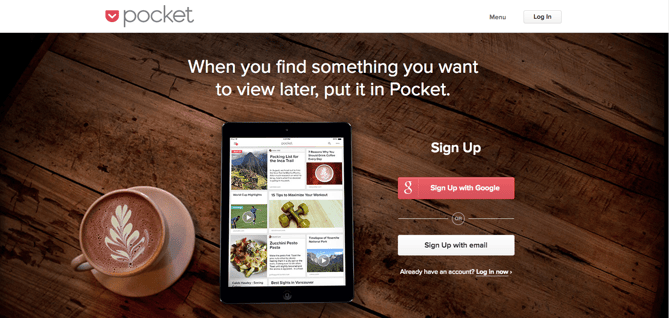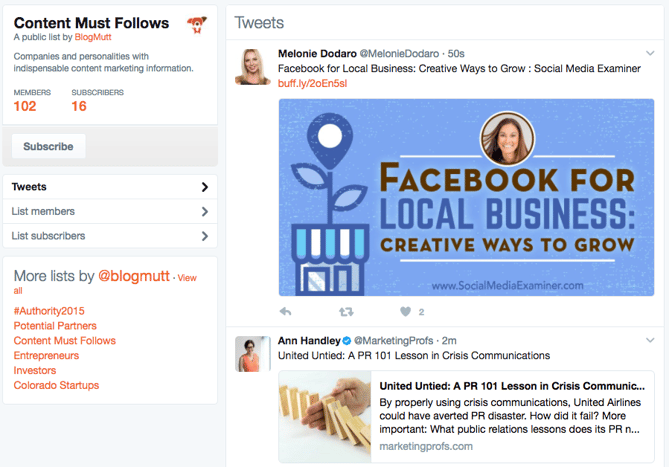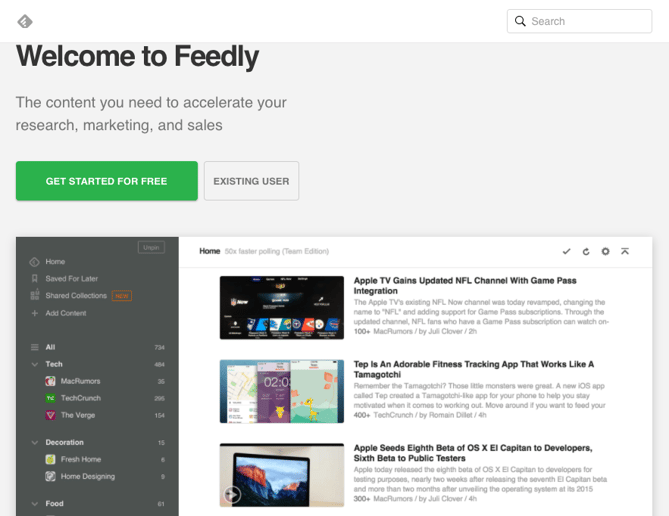If you’re thinking, “Yeah, I occasionally share a relevant post with my customers when I find one,” congratulations — you’re curating content. Unfortunately, you’re not doing so on a sustainable scale that makes you a trusted source.
But don’t worry — there are better ways to curate content for beginners that are completely free. Here are three simple sources of information to help you start getting in the habit of curating content, without being overwhelmed by complex tools, subscription fees or convoluted dashboards.
1) Pocket

Pocket is a great place to get into the habit of accruing content to save and share later. Instead of a laundry list of bookmarks or countless emails you’ve sent to yourself with links, it keeps all your interesting images, articles, and videos in one place for reference. You can group articles with tags, and the site’s built-in search functionality makes finding those articles easy. Plus, it integrates with over 500 other apps, like Evernote, for seamless integration.
And as a bonus, Pocket tweets out their @PocketHits for the most-saved articles on their platform — a must-follow if you’re active on Twitter. For other “read-it-later” apps like Pocket, check out Instapaper.
2) Twitter Lists

Twitter can be a streaming mess if you don’t organize the accounts you follow. That’s where Twitter lists come in handy — curated groups of Twitter users that you can categorize and follow separately from the rest of your feed. Here’s one that I created, which I continually manage and update. Even better, if you create a Pocket account, you can easily save articles from Twitter directly into your account.
Click here to learn how to start your first Twitter list.
3) Newsletters
Newsletters serve as a fantastic daily reminder to get your content curation done. For example, I follow HubSpot on Twitter, but don’t always get a chance to see its tweets when I’m busy. Fortunately, HubSpot also offers an email subscription. That way, if I don’t catch something notable on social media, I’m likely to catch it on email.
Whatever industry you’re in, stay on the lookout for newsletter subscriptions. And if a good one doesn’t exist in your industry, that’s the perfect opportunity to create one. But before you start your own newsletter, learn from what other outlets are doing. Here are a few that are doing a great job in original content curation:
- Redef: Jason Hirschhorn, one of the pioneers in social media and formerly the co-president of MySpace, has launched a site curating the best in media, sports, fashion, music and technology. Subscribe to one of Reder’s newsletters for a taste of one of the best in content curation.
- Quartz Daily Brief: Quartz has figured out how to make a text-heavy newsletter a stalwart in the news business with its Daily Brief. The beauty of the newsletter, because it’s text-based, is the cross-platform functionality. Without heavy images, the Daily Brief loads quickly on phones, tablets, and desktops, making it easy to read on any device.
- Internet Brunch: Digital agency Big Spaceship created Internet Brunch to help folks “find the best news, GIFs, and trends from across the Internet.” From holidays, to current events, to celebrity birthdays, this roundup is sure to cover the important stuff that helps readers stay in the loop.
For Intermediates
Here are some great sources for when you’ve got the basics covered — resources like newsletters, social media, and read-it-later apps. But you’re looking for something a little more comprehensive, and if you’re willing to pay for a subscription, these are the comprehensive, algorithmically generated digests of news, feeds, and content to check out.
4) Scoop.it
Pricing: Free – $67/month

I like to think of Scoop.it as a nexus of content curation and social media, with a Pinterest-like user interface. Start with a topic of interest, and Scoop.it will not only generate the most relevant articles to view and share, but also, will suggest complementary topics and other Scoop.it users to follow. The site sends a daily update of the topics you follow, too, to help you keep pace with the most relevant articles to share.
The free version allows you to monitor one topic for posting, on two social media accounts. For a more robust platform that follows multiple topics for sharing across all your social channels, you might want to look into the paid options.
5) Feedly
Pricing: Free – $18 per user, per month

Feedly is a supercharged RSS Feed. Here, content curation takes two routes: There’s web browsing 1.0 which is essentially visiting one site at a time, copying a URL, and pasting it accordingly. Then, there’s the news aggregation route that’s powered by Feedly. By simply adding a few of your favorite sources to Feedly, you can aggregate and browse these feeds in one place from your desktop and mobile devices. You can find a visual tutorial here.
You can read more here.
This article is curated by Blogging Informer and it posted on hubspot.com
- May 22, 2019
- 0 Comments
